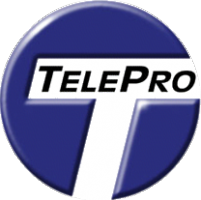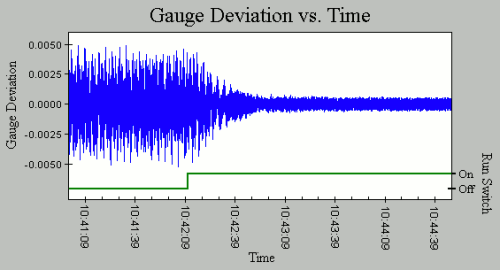VEG/EE Gauge Control System
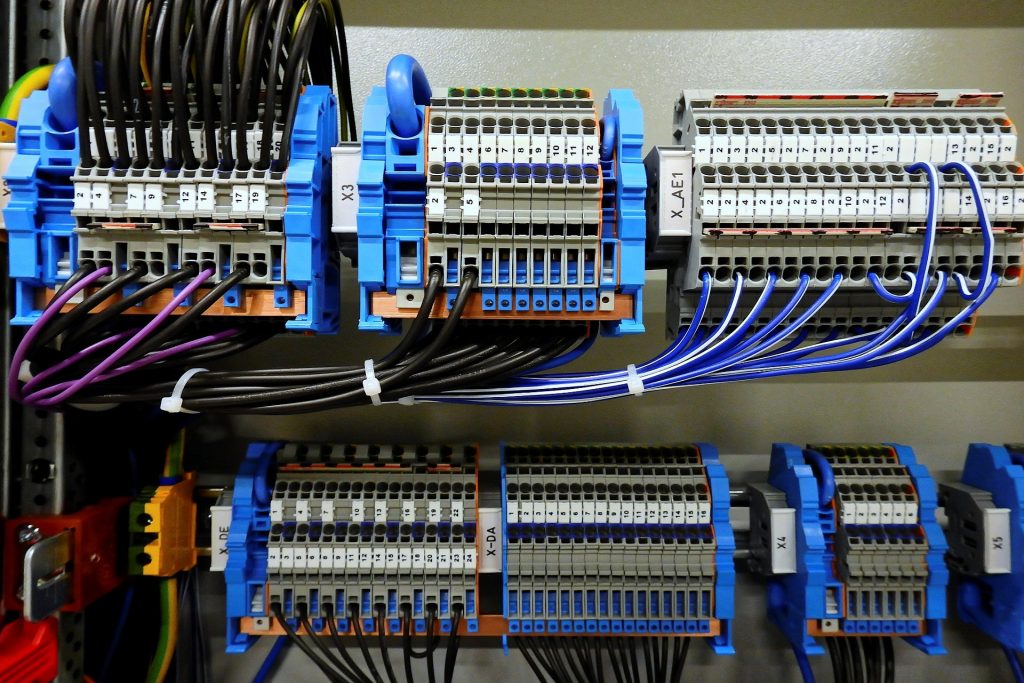
Introduction
The gauge thickness variation of a rolled product is often considered one of the most important measures of the quality of the product. It is a measure of how closely the exit gauge tracks the desired nominal gauge as the sheet passes through the rolling mill. In practice, the largest contributors to excessive power in the gauge thickness variation are periodic disturbances occurring at frequencies higher than a typical feedback gauge control system is capable of tracking.
Existing solutions to this problem come in two flavors. The first is to install an entry gauge and implement a feed forward gauge control system. However, this requires a large investment of several hundred thousand dollars in equipment and maintenance for an entry gauge. More importantly, such a system is only capable of eliminating disturbances present on the incoming sheet; it can have no effect towards reducing periodic disturbances imprinted on the sheet by the rolling stand itself, such as those due to roll eccentricities. Hence eccentricity compensation systems, the second flavor of gauge thickness variation solutions, have been developed to eliminate in-stand disturbances, and indeed they have proven to be quite effective. Still though, today's solutions require position encoders mounted on each roll within the stack in order to lock the phase between the disturbances and the corrective action, imposing additional hardware and maintenance requirements. Furthermore, because of the encoders these systems are limited to disturbances caused by the rolls themselves, and cannot effectively reduce disturbances due to other in-stand mechanical components such as the unwind and rewind handling equipment.
The VEG/EE system is designed to succeed exactly where previous systems are lacking. It does not require an entry gauge nor roll rotation encoders, and it is not limited only to those disturbances present on the incoming sheet nor to disturbances tied to the discrete rotation frequencies of the rolls in the stack. Instead, VEG/EE replaces the expensive and maintenance-hungry entry gauges and roll encoders with the latest in digital signal processing software capable of identifying, tracking, and eliminating cyclical disturbances present in the material exit gauge given a bare minimum of inputs.
System Overview
The Virtual Entry Gauge/Encoderless Ecomp System (VEG/EE) is a complete, self-contained, process control system designed to significantly and efficiently remove all cyclic components in the gauge of a rolled material, thus substantially reducing the gauge thickness variation of the product. Its advantages include:
- Feed forward gauge control performance without the instrumentation
This system can identify and remove cyclic gauge disturbances found in the incoming material without the requirement of an entry gauge. - Encoderless roll eccentricity compensation
This system can compensate for cyclical gauge disturbances caused by roll eccentricities without the necessity for position encoders. - Packaged on PC platform
The system is packaged on a standard IBM PC running Microsoft Windows with IntervalZero RTX real time extensions. - Minimal I/O requirements
A bare minimum of mill-standard analog input signals are required and data acquisition is performed with a single internal PCI card. - User interface
All user interface is performed through a desktop application that can be installed on any Windows terminal. - Easy deployment
Because of its self-contained nature the system can be treated as a modular add-on to any existing mill control system.
Virtual Entry Gauge
Conventional gauge control systems based on exit gauge data have limited performance due to delayed feedback response. Major improvements come only with feed forward control, which in turn requires costly instrumentation. The VEG portion of the system, however, is capable of finding and correcting periodic disturbances present in the material incoming to the mill. Typically, such disturbances are due to fluctuations in the casting process or the effects of previous rolling passes and are too fast to be corrected by normal exit gauge feedback control. Hence digital signal processing algorithms are used to analyze harmonics in the exit gauge data and to compute the appropriate feedback control response, in effect providing the functionality of a virtual entry gauge. All entry disturbance frequencies within the dynamic frequency response of the mill control system can be identified and corrected.
Encoderless Ecomp
Today's state-of-the-art eccentricity compensations systems require encoders mounted on each of the rolls in order to synchronize the control outputs with each roll's position. The EE portion of the system employs advanced phase tracking algorithms to follow the positions of the individual rolls and and lock the phases of the control outputs to the roll positions and consequently with the actual disturbances. Tracked frequencies may be at the fundamental frequency or any harmonic frequency of any of the rolls within the response of controlling actuators.
PC Platform
The VEG/EE system is packaged on the PC compatible hardware platform under Microsoft Windows 10 (or later). IntervalZero's RTX real-time extensions are used for high-resolution timers providing process rep rates as fast as every 1 ms. Not only are the hardware and software requirements low, inexpensive, and readily available but also the system runs in an environment with which most users are quite familiar, thus vastly simplifying system installation, commissioning, and maintenance.
Minimal I/O requirements
The VEG/EE system uses an internal PCI data acquisition card for high speed I/O. It requires only a handful of analog inputs standard on any mill gauge control system, namely:
- Mill speed (sampled at 1 kHz)
- Exit gauge deviation (sampled at 1 kHz)
- Unwind coil diameter (sampled at 1 Hz)
- Unwind current (sampled at 1 Hz)
In return, the VEG/EE system provides the following analog outputs:
- Gap position correction (updated at 1 kHz)
- Unwind current correction (updated at 1 kHz)
In addition, several digital I/O signals are provided to automate system turn on and shut off and to indicate the current system status.
User Interface
The entire user interface is provided as a desktop application that can be loaded onto any network accessible workstation. Screens are provided to display:
- Frequencies, magnitudes, and phases of all currently tracked sinusoids
- Real-time FFT displays of actual exit gauge vs. theoretical uncorrected exit gauge
- Statistical process analysis
- Algorithmic tuning parameters
- Real-time and historical trends of any internal data
- System maintenance and management information
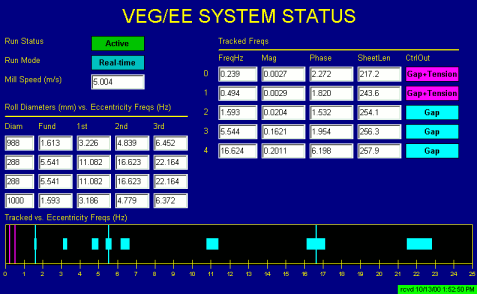
System Deployment
The VEG/EE system is designed to be fully integrated with any existing mill control system. As described above, the system can be turned on via a single digital input signal. Indeed, all input and output signals are optically isolated, making it safe and easy to install without adversely affecting legacy equipment and control systems. Analog input signals can simply be wired in parallel to existing signals - all four would be required by and readily available from any existing mill control system that you might have. On the other hand, analog output signals are designed to be added in to the corresponding control outputs from the existing gauge control system.
Schedule parameters are read from a flat ASCII file prior to every run in order to calculate system gains based on strip width, nominal exit gauge, etc. This file can easily be updated from your existing system for each new coil via network transfer, thus fully automating the VEG/EE system.
Conversely, if you do not currently have a mill control system or if you are unsatisfied with your existing system, VEG/EE can be seamlessly packaged together with an optional TelePro/SSE standard automatic gauge and tension control system running in the same box. Like the stand-alone VEG/EE system, this system runs at 1 ms rep rates to control the nominal material exit gauge.
Demonstration
A complete demonstration of the VEG/EE system on your own mill can be accomplished in under a week, including system setup, commissioning, and several rolled coils. All that is required is access to the six real-time analog signals described above, while, for the purposes of a demonstration, the system can be turned on and off by hand and all mill and schedule dependent parameters entered manually.
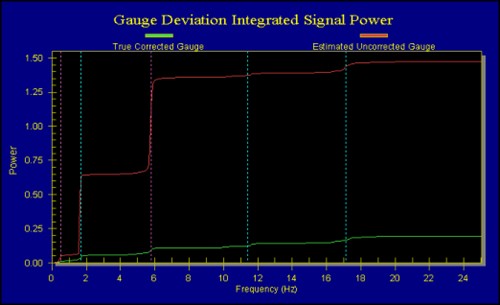
Contact
If you have any interest in the Virtual Entry Gauge / Encoderless Ecomp system please contact us.
System Notes
- VEG/EE is offered as a complete system. Hardware is provided with manufacturer's warranty. System software is provided under license from Microsoft and IntervalZero. License to use the application software on a single system is provided by TelePro, Inc.
- This system is protected by applicable US patent and intellectual property law. Application has been made for US and foreign patents.
- Prices available on request.
- Windows is a trademark of Microsoft Corporation.
- RTX is a trademark of IntervalZero, Inc.
- VEG/EE is a trademark of TelePro, Inc.
